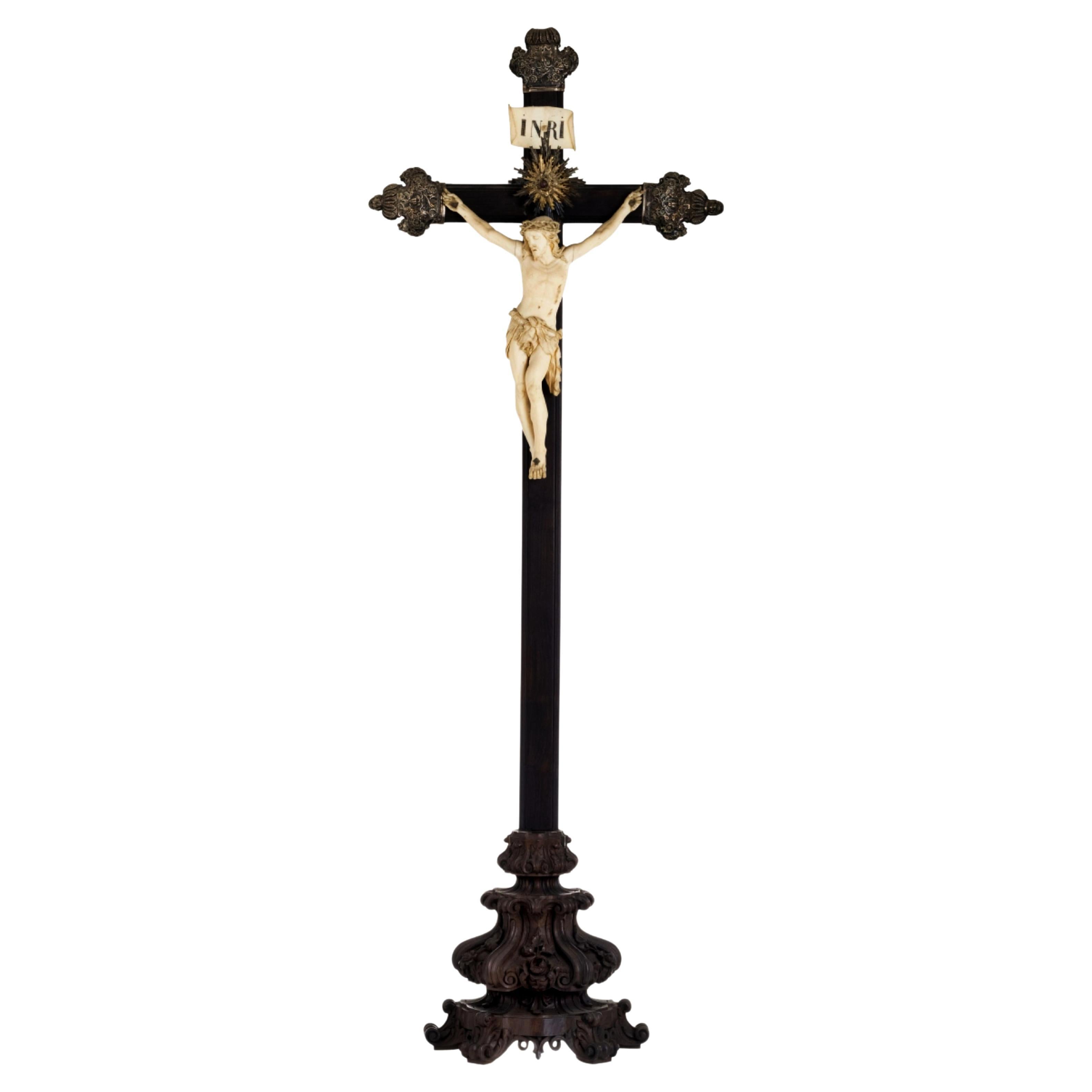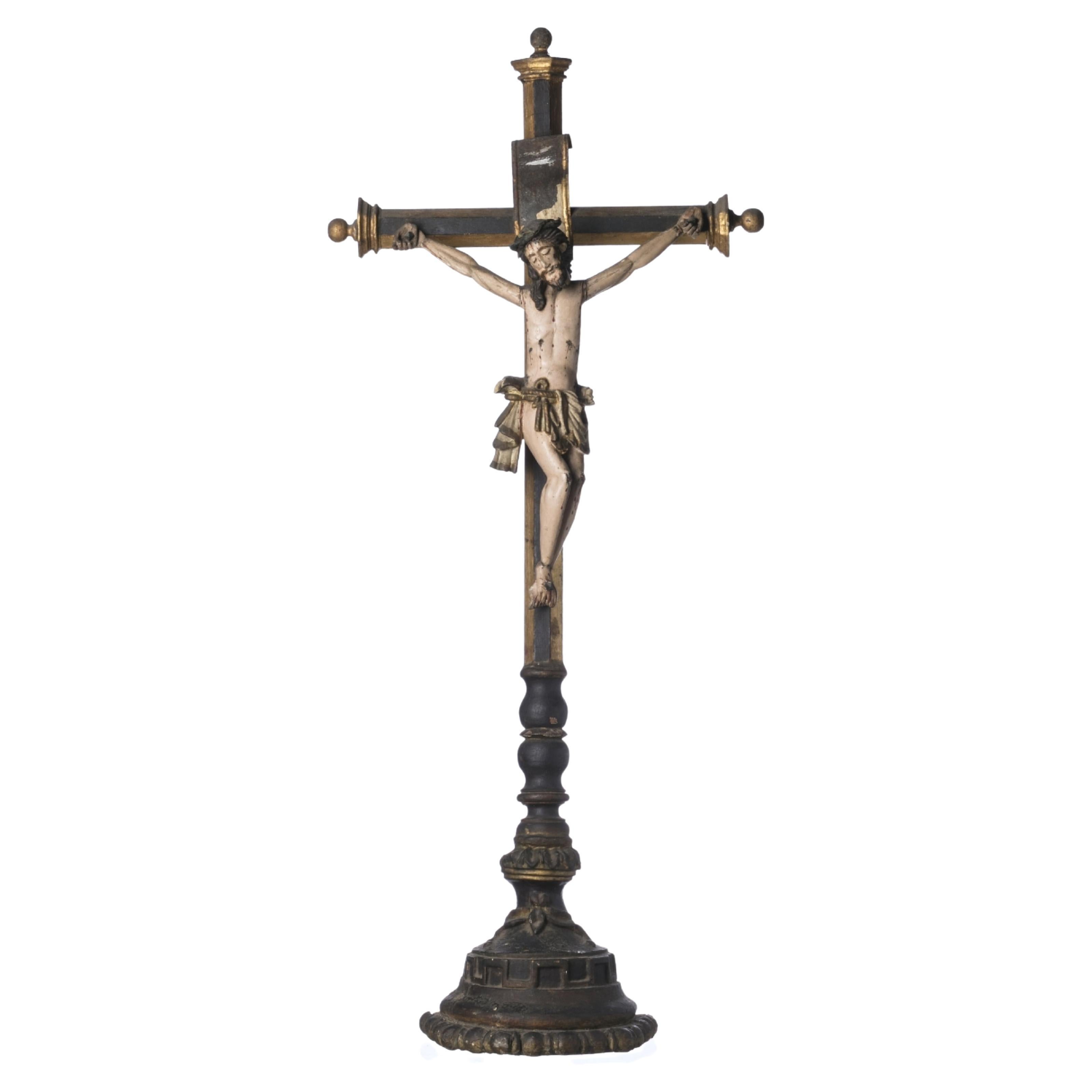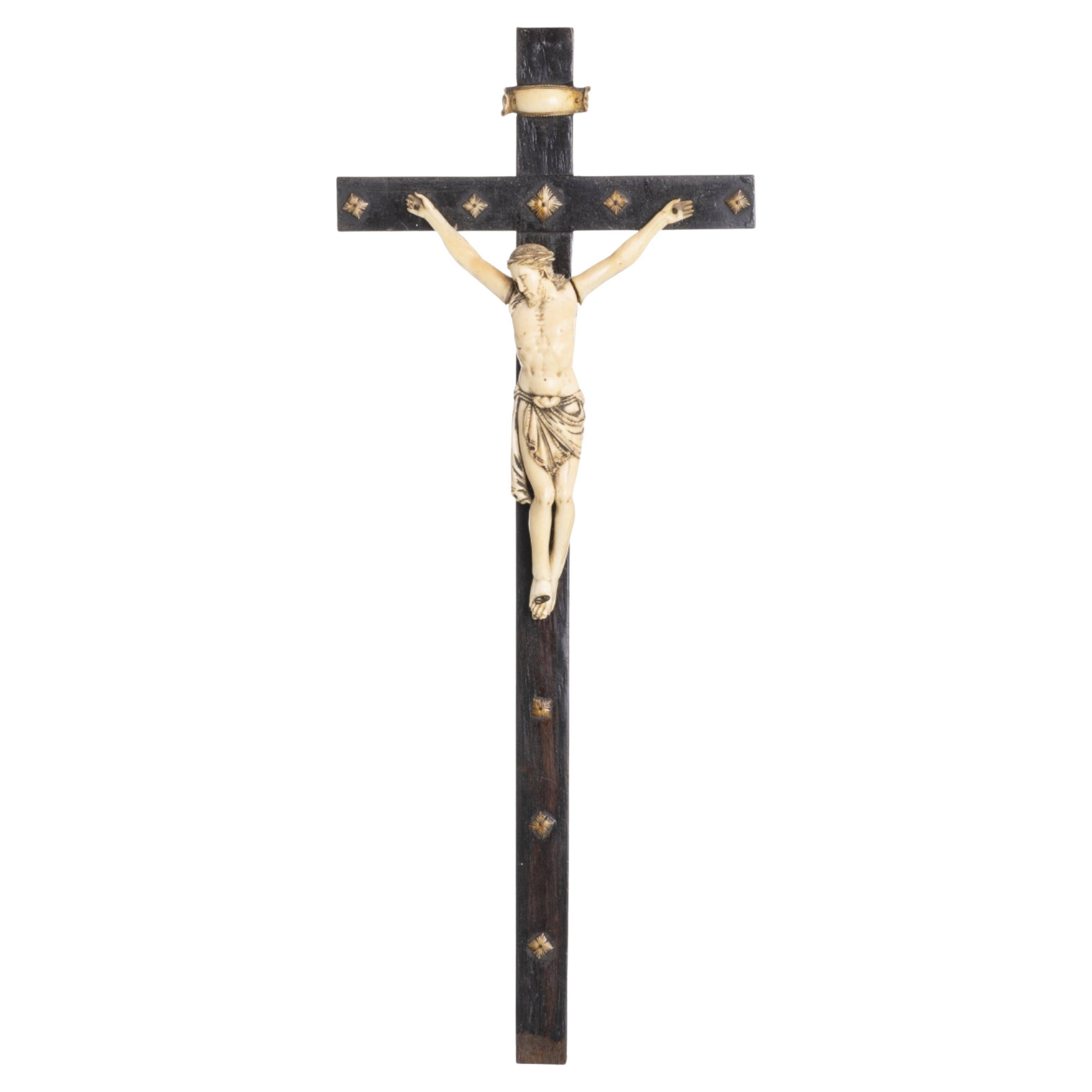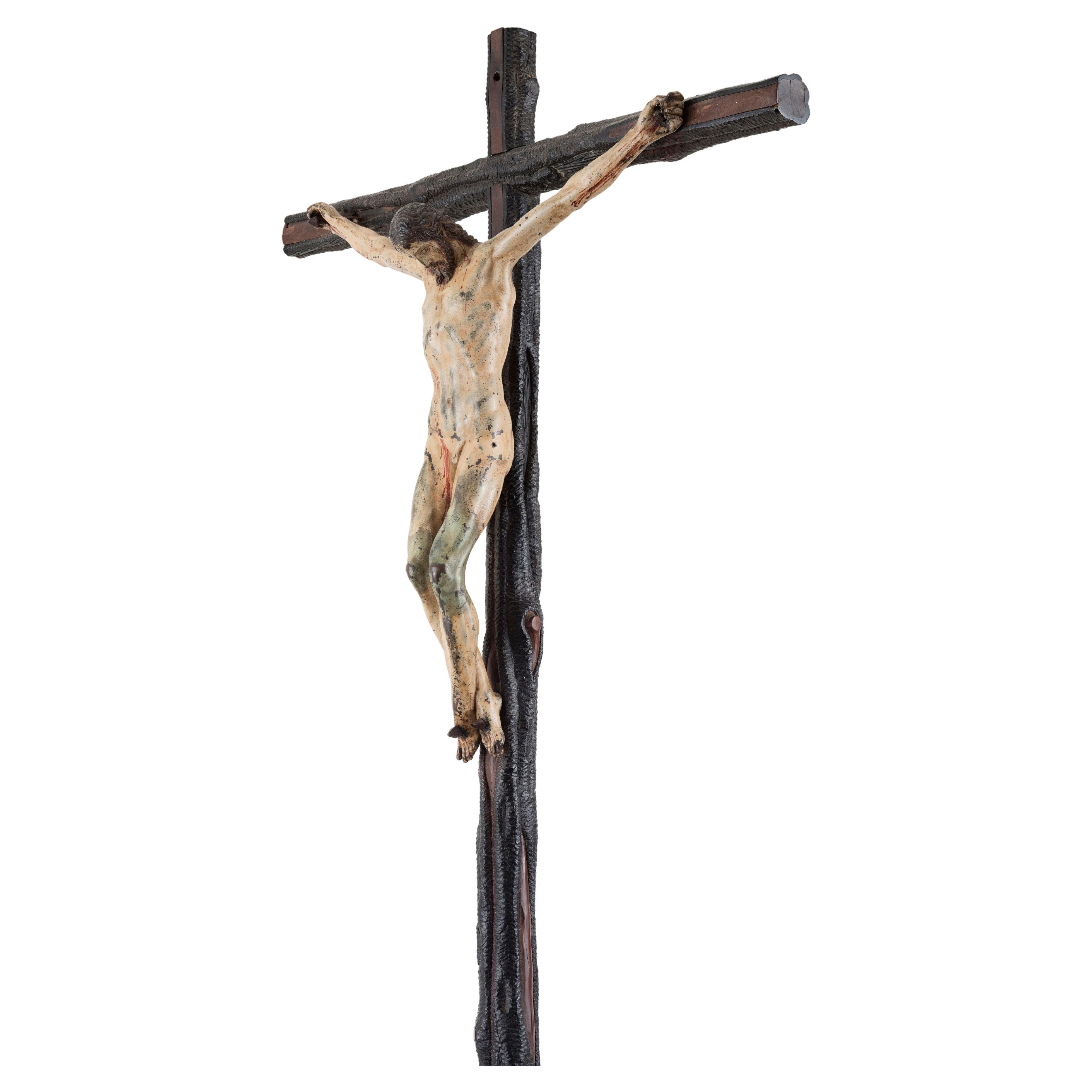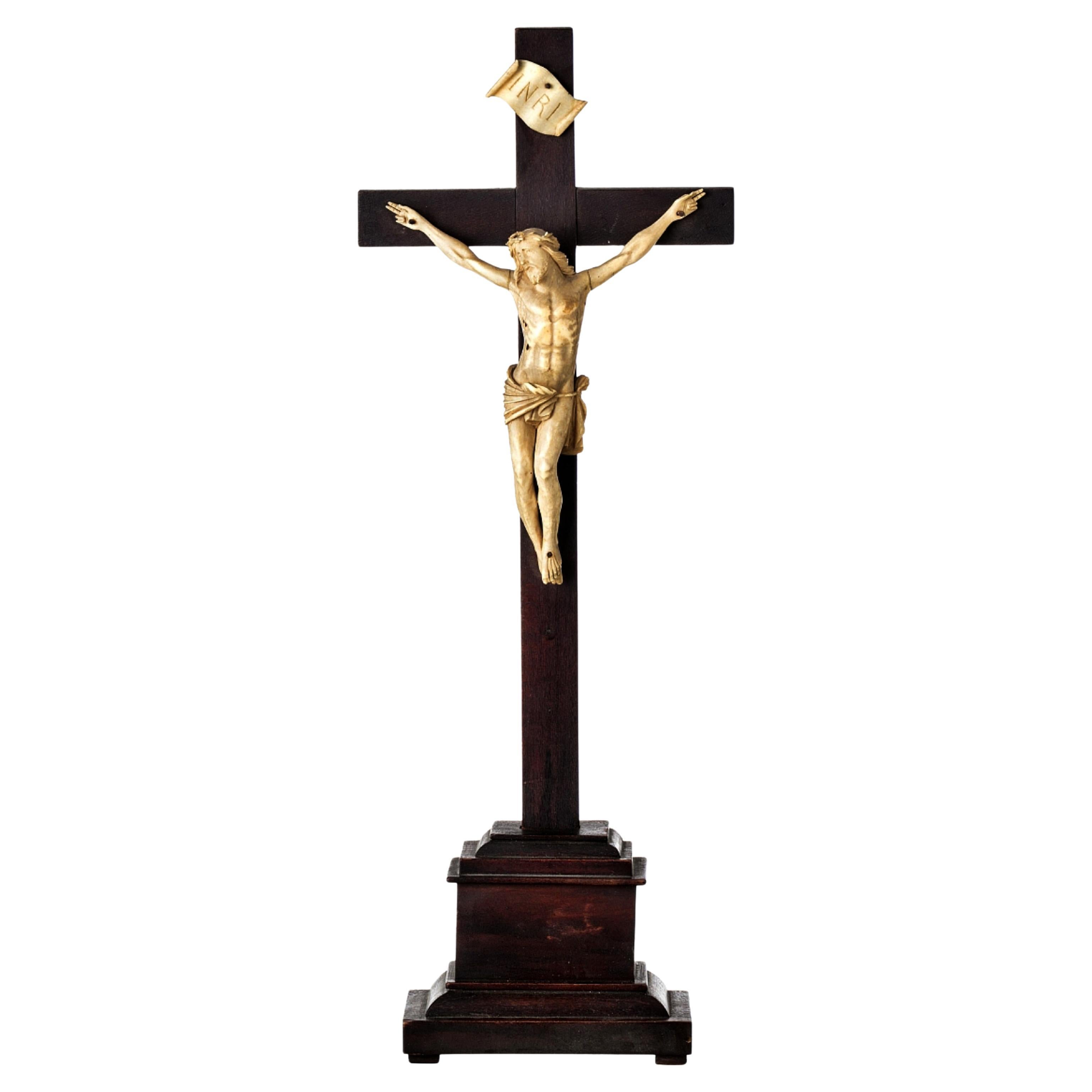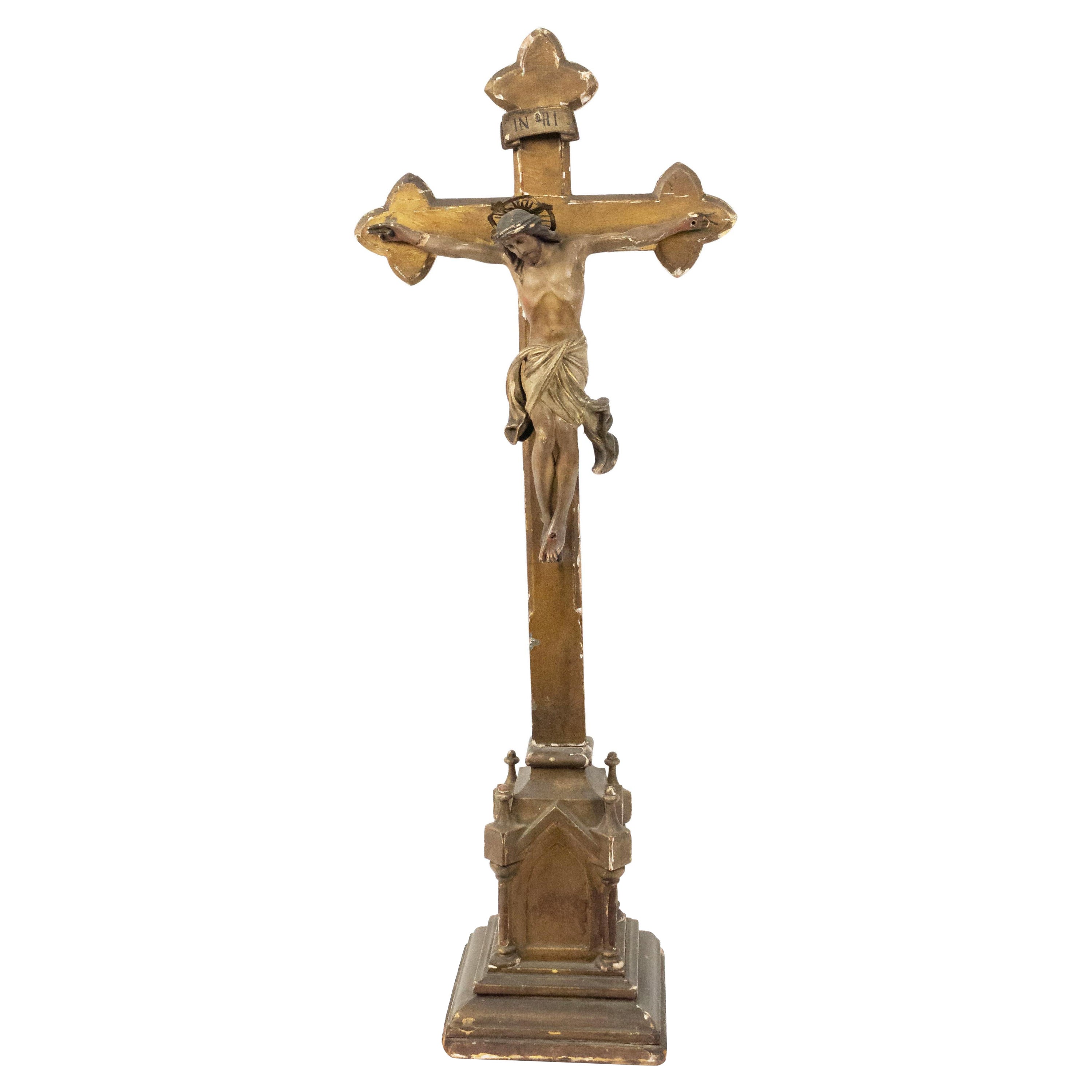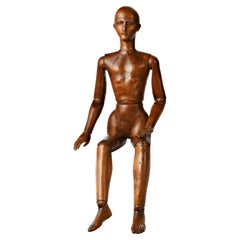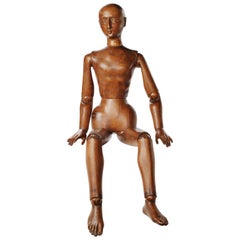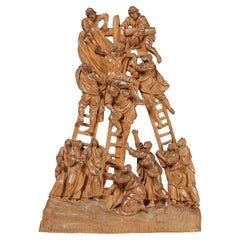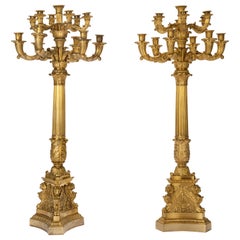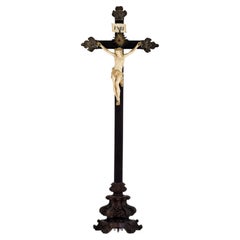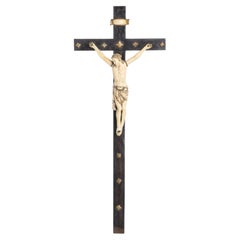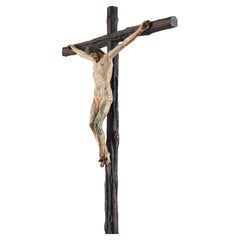Items Similar to Crucifix, Bronze, iron, and wood, Lombardy, mid-17th century
Video Loading
Want more images or videos?
Request additional images or videos from the seller
1 of 17
Crucifix, Bronze, iron, and wood, Lombardy, mid-17th century
$17,316.60
£12,805.09
€14,500
CA$23,786.02
A$26,448.69
CHF 13,846.37
MX$323,075.72
NOK 173,993.25
SEK 163,675.52
DKK 110,406.33
About the Item
Crucifix
Lombardy, mid-17th century
Bronze, iron, and wood
Sculpture: 33 cm height x 35 cm width x 10 cm depth at the knees;
Cross: 42.12 in height x 19.68 in width (107 cm x 50);
Base: 13.38 in height x 13.58 in width x 7.08 in depth. (34 cm x 34.5 x 18)
Total dimensions: 54.33 in height x 19.68 in width x 7.08 in depth (138 cm x 50 x 18)
Weight: 18.07 lb (8.2 kg)
State of conservation: some signs of wear on the bronze patina, a dent on the halo.
The sculpture depicts Christ dead on the cross, with his head tilted to the right and his arms stretched upwards and to the side. The body is positioned frontally with the right leg slightly twisted at the knees. The loincloth is very minimal and gathered on the right with a knotted cord. The head is surmounted by an iron halo fixed by a nail. The wound from the spear that pierced Christ after his death, as well as the drops of blood and water that flowed from it, are reproduced on his side. The face is delicately modeled with defined features, closed eyes and mouth, and beard and moustache. The hair, parted in the middle, falls in long strands forward and down the back to the right.
The crucifix model can be traced back to some works designed by Guglielmo Della Porta (ca. 1515-1577), a sculptor, architect, and restorer of Italian Mannerism, who was trained in Genoa and Rome. He was a disciple of Michelangelo and later a sculptor at the Farnese court.
Over time, this model was attributed to Giambologna (1529-1608), who was active in the creation of crucifixes around the 1570s. This is an idea that still has various supporters (Michael Riddick, Reconstituting a Crucifix by Guglielmo Della Porta and his Colleagues. The "Great School" of Guglielmo Della Porta, Part 2, 2017 link).
More recent studies, instead, follow a different path to reconstruct the history of this sculpture and tell us with certainty that in 1569 Alessandro Farnese (1520-89) requested that Guglielmo Della Porta produce "some crucifixes in solid silver and other gilded metals" for St. Louis. Peter's Basilica (Anna Beatriz Chadour, The Altar Set by Antonio Gentili in St. Peter's Basilica. Peter's, Rome. Wallraf-Richartz-Jahrbuch, vol. 43, 1982, pp. 133-193). Guglielmo's workshop was one of the most active at the time, as confirmed by the large number of crucifixes inventoried at the time of his death in 1577: the list includes at least 58 examples, in various stages of production, ranging from 22 to about 70 centimeters in size (Rosario Coppel, Catalogue (Christ Crucified.) Guglielmo Della Porta, A Counter-Reformation Sculptor, Madrid 2012, pp. 62-73).
In well-organized workshops, it was customary for much of the production of replicas to be entrusted to the master's collaborators and pupils. It is very likely that this was also the case in Guglielmo's workshop, where it is possible to find various examples starting from one of his prototypes and resulting in inevitable, and at times great, variations
Among the works of artists who collaborated with the master, the model closest to ours seems to be that of Antonio Gentili da Faenza, the presumed author of the example kept in the Apostolic Palace of the Sanctuary of Loreto.
The corpus of works associated with the Loreto crucifix also includes the model conceived by Guglielmo in 1571 for Cardinal Alessandro Farnese and later elaborated by Gentili, as evidenced by some epistolary documents (State Archive of Naples cited in Rosario Coppel, Guglielmo Della Porta in Rome. Guglielmo Della Porta, A Counter- Reformation Sculptor. Madrid 2012, pp. 28-57).
In this regard, it has been noted how in the Farnese altar cross in the Vatican, Gentili's finishing can be seen in some evident variations from Della Porta's original design: for example, in the circular shape of Christ's umbilicus (triangular in Della Porta's model), in the treatment of the hair, the shape of the hands, and especially the loincloth, which is completely reworked and draped at the back of Christ's right leg.
Therefore, Guglielmo's prototype, perfected and cast by Gentili, proves that the Loreto crucifix is not an invention of Giambologna, but represents one of the many workshop variants based on Guglielmo's Crucifix of 1571 for Alessandro Farnese in the Vatican (Michael Riddick, op. cit., p. 15).
The model of Christ on the cross by Della Porta and its variants have had great success over time, becoming one of the most widely used templates to meet the demands of religious commissions and private devotion.
The work in question is accompanied by an important ebonized wooden base, which, in morphology and style, can be associated with Lombard production of the 17th century and the early decades of the 18th. The style of the base is evidently found in decorative formulas that are repeated in the architectural plinths of the cornices of palaces or in the brackets of Lombard churches up to the decorative components of contemporary furniture and objects. This style, in our opinion, is consistent with the crucifix and in harmony with the dictates of the Council of Trent, now fully embraced, which supported a new form of art suitable for promoting the message of the Christian Catholic Church, even through beauty and a certain, often theatrical, decorativeness.
Bibliography:
Michael Riddick, Reconstituting a Crucifix by Guglielmo Della Porta and his Colleagues. The "Great School" of Guglielmo Della Porta, Part 2, reconstituting-a-crucifix-by-guglielmo-della-porta-and-his-colleagues/, and related bibliography;
Rosario Coppel, Guglielmo Della Porta in Rome. Guglielmo Della Porta, A Counter-Reformation Sculptor. Coll & Cortés 2012;
Werner Gramberg, Sechs Sammler Stellen Aus. Museum für Kunst und Gewerbe Hamburg, Hamburg, 1961, No. 43;
Werner Gramberg, Das Kalvarienbergrelief des Guglielmo Della Porta und seine Silber-gold-Ausführung von Antonio Gentili da Faenza. Intution und Kunstwissenschaft. Festschrift für Hans Swarzenski. Berlin 1973;
Werner Gramberg, Notizen zu den Kruzifixen des Guglielmo Della Porta und zur Entstehungsgeschichte des Hochaltarkreuzes in S. Pietro in Vaticano
In Münchner Jahrbuch der bildenden Kunst vol. 32, 1981;
Ulrich Middeldorf, Palazzo Vecchio: Medici patronage and collecting, Florence and the Tuscany of the Medici in Sixteenth-Century Europe. Florence 1980. N. 674;
Anna Beatriz Chadour (1982): Der Altarsatz des Antonio Gentili in St. Peter zu Rom. Wallraf-Richartz-Jahrbuch, vol. 43.
- Dimensions:Height: 54.34 in (138 cm)Width: 19.69 in (50 cm)Depth: 7.09 in (18 cm)
- Style:Baroque (Of the Period)
- Materials and Techniques:
- Place of Origin:
- Period:Mid-17th Century
- Date of Manufacture:Circa 1650
- Condition:Wear consistent with age and use. Some signs of wear on the bronze patina, a dent on the halo.
- Seller Location:Milano, IT
- Reference Number:1stDibs: LU4352240552672
About the Seller
4.3
Vetted Professional Seller
Every seller passes strict standards for authenticity and reliability
Established in 1860
1stDibs seller since 2018
21 sales on 1stDibs
Associations
International Confederation of Art and Antique Dealers' Associations
- ShippingRetrieving quote...Shipping from: Milano, Italy
- Return Policy
Authenticity Guarantee
In the unlikely event there’s an issue with an item’s authenticity, contact us within 1 year for a full refund. DetailsMoney-Back Guarantee
If your item is not as described, is damaged in transit, or does not arrive, contact us within 7 days for a full refund. Details24-Hour Cancellation
You have a 24-hour grace period in which to reconsider your purchase, with no questions asked.Vetted Professional Sellers
Our world-class sellers must adhere to strict standards for service and quality, maintaining the integrity of our listings.Price-Match Guarantee
If you find that a seller listed the same item for a lower price elsewhere, we’ll match it.Trusted Global Delivery
Our best-in-class carrier network provides specialized shipping options worldwide, including custom delivery.More From This Seller
View All19th Century Italian Wood Mannequin, Circa 1870-1880
Located in Milano, IT
Mannequin
Sculpted and carved wood
Italy or France, second half of the 19th century.
It measures 25.59 x 6.29 x 3.54 in (65.5 x 16 x 9 cm)
It weighs 2.2 lb circa (1 kg circa)
St...
Category
Antique 1870s Italian Other Figurative Sculptures
Materials
Wood
Late 19th Century Italian Wood Mannequin, circa 1880
Located in Milano, IT
Atelier mannequin
graven and carved stone pine wood
Italy, late 19th century
Measures: H 102 cm x 25 cm x 14 cm
H 40.15 in x 9.84 in x 5.51 in
Weight: circa kg 4
State of conse...
Category
Antique 1880s Italian Other Figurative Sculptures
Materials
Wood
Ancient Boxwood Micro Carving Deposition, First Half of the 18th Century
Located in Milano, IT
Boxwood micro carving
Deposition
Central Europe, first half of the 18th century
It measures: the sculpture 7.40 x 5.31 x 0.6 in (18.8 x 13.5 x 1.6 cm); w...
Category
Antique 1740s European Baroque Figurative Sculptures
Materials
Boxwood
19th Century Pair of French or Russian Gilt Bronze Candelabra, circa 1830
Located in Milano, IT
Pair of thirteen-flame candelabra
France or Russia
Second quarter of 19th century
Cast, chiseled and gilt bronze
Height 40.95 in (cm 104), diameter 17,7 in (cm 45)
97 lb (44 kg)
Sta...
Category
Antique 1830s French Neoclassical Candelabras
Materials
Ormolu
19th Century Italian Sterling Silver Madonna, circa 1830
Located in Milano, IT
Embossed and engraved silver plaque
La Madonna del lago (The Madonna of the Lake)
Probably Milan, post 1824
Brass frame
It measures 16.14 in x 13.85 in (41 x 35.2 cm) and it weighs 10.357 pounds (4.698 g): silver 1.31 pounds (598 g) + brass 9.03 pounds (4.100 g)
State of conservation: some abrasions on the bottom. The frame is old, but not original.
The plaque is made up of a sheet of embossed and engraved silver, and held in a solid brass frame. It depicts the “Madonna del lago” – “Madonna of the Lake” - (the Madonna with Child and San Giovannino) by Marco d'Oggiono (Oggiono, 1474 circa - Milan, 1524 circa), while changing only the background landscape. Almost certainly the subject reproduced in the plaque was taken from a famous engraving by Giuseppe Longhi (Monza, 1766 - Milan, 1831), one of the greatest engravers of his era.
The silver is unmarked, probably because originally the Madonna was due to be exposed in a church: sometimes precious metals destined for worship and liturgical use would be exempted from payment and were, therefore, not marked.
It is very likely that the plaque was made in Milan because in this city in 1824 the engraving by Giuseppe Longhi was made and printed. In addition, in Milan, the alleged lost painting by Leonardo da Vinci in his Milanese period (1482-1500) would be produced; this is the painting from which Marco d'Oggiono took his version.
The painting
Marco d?Oggiono was one of Leonardo da Vinci's most brilliant students and collaborators (D. Sedini, Marco d’Oggiono, tradizione e rinnovamento in Lombardia tra Quattrocento e Cinquecento, Roma 1989, pp. 151-153, n. 56; p. 225, n. 124, with previous bibliography). His style reflects in every way that of the Tuscan Maestro, so much so that he was the one who executed some copies of da Vinci's paintings. The execution of the “Madonna del Lago” probably draws inspiration from a lost painting by the Maestro, created while he was living in Milan (1482-1500). There are many similarities with other works by Leonardo such as the “Vergine delle rocce” or the “Vergine con il Bambino e San Giovannino, Sant’Anna e l’Agnello”.
The painting, from which the drawing and then the famous engraving were taken, is found today at the M&G Museum of Bob Jones University in Greenville, South Carolina, where it came to rest after the sale of the Harrington Collection in London in 1917.
The work appears in the inventories of the collection of Napoleon and Joséphine Bonaparte at the castle of Malmaison, before 1809.
The Malmaison building was born and developed in the 17th and 18th centuries. In the 18th century it belonged to Jacques-Jean Le Coulteux du Molay, a wealthy banker. Later, during the Directory, Joséphine Bonaparte de Beauharnais bought it on April 21st, 1799, but settled at the castle definitively only after her husband separated from her in 1809. She remained there until 1814, the year of her death. When Joséphine died, the estate passed to her son Eugène de Beauharnais, who moved to Munich with his whole family in 1815, bringing with him the collection of paintings he inherited from his mother. Eugène died in 1824 and his wife Augusta of Bavaria (von Bayern), unable to keep it, in 1828 sold the Malmaison to the Swedish banker Jonas-Philip Hagerman.
It is likely that in this period Augusta also sold part of the paintings inherited from her husband, including the “Madonna del Lago”. This painting then came into the possession of Leicester Stanhope, fifth Earl of Harrington (1784 - 1862) and then was passed down to his descendants.
In 1917, at the death of Charles, eighth Earl of Harrington, his brother Dudley inherited the title and properties and he put up a part of his collections for sale. Among these, precisely, the painting by Marco d'Oggiono was to be found.
On the occasion of that auction the painting was presented as a work by Cesare da Sesto, by virtue of a handwritten note by the Countess of Harrington on the back of the table. However, already in 1857, the German critic Gustav Waagen had identified Marco d'Oggiono as the author of the painting, then exhibited in the dining room of Harrington House in London (Treasures of Art in Great Britain, in 4 volumes, London, 1854 and 1857).
The engraving
Giuseppe Longhi was one of the most renowned engravers in Italy between the end of the 18th century and the first quarter of the 19th century.
In 1824 Giuseppe Longhi, based on a design by Paolo Caronni, made a famous engraving of the painting of Marco d?Oggiono. The activity of Longhi was then at the peak of his notoriety, enough to earn him very substantial commissions; it is not risky to suppose that some of his successful engravings were also reproduced using other means: in our case in silver. (A. Crespi, a cura di, Giuseppe Longhi 1766–1831 e Raffaello Morghen...
Category
Antique 1820s Italian Neoclassical Sterling Silver
Materials
Sterling Silver, Brass
Pair of French Three-Flame Candelabra Candelabra, circa 1860
Located in Milano, IT
Pair of three-flame candelabra
Cast bronze, chiselled and mercury gilded
France, third quarter of the nineteenth century
Height 14.96 in (38 cm) X 12.59 (32 cm)
Weight 11.46 lb ...
Category
Antique 1860s French Napoleon III Candelabras
Materials
Bronze
You May Also Like
JESUS CHRIST CRUCIFIED 18th Century Italian Sculpture
Located in Madrid, ES
JESUS CHRIST CRUCIFIED 18th Century
Italian Sculpture
in ivor.... The figure is represented dead, wearing a cendal point at the waist. Cross in carved rosewood wood. Silver termin...
Category
Antique Early 18th Century Italian Baroque Religious Items
Materials
Wood
$3,343 Sale Price
20% Off
JESUS CHRIST CRUCIFIED Portuguese Sculpture from the 17th Century
Located in Madrid, ES
JESUS CHRIST CRUCIFIED
17th Century Portuguese sculpture
in carved wood, polychrome and gilded.
Small flaws in the polychromy.
Height: (Christ) 32 cm. Height: (total) 86 cm.
good co...
Category
Antique 17th Century Portuguese Baroque Religious Items
Materials
Wood
$1,668 Sale Price
20% Off
JESUS CHRIST CRUCIFIED Cross in Exotic Wood, 19th Century Portuguese Sculpture
Located in Madrid, ES
JESUS CHRIST CRUCIFIED
Cross in exotic wood, 19th Century Portuguese sculpture
carved in ivor...
Signs of use. Dim. Height: (christ) 16 cm; (total) 45 cm
good conditions
Category
Antique 19th Century Italian Baroque Religious Items
Materials
Wood
$2,388 Sale Price
20% Off
Rare and important painted bronze Crucifix after a model by Michelangelo
By Michelangelo Buonarroti
Located in Leesburg, VA
A rare and very fine bronze corpus of Christ after a model by Michelangelo, cast ca. 1597-1600 by Juan Bautista Franconio and painted in 1600 by Francisco Pacheco in Seville, Spain.
The present corpus reproduces a model attributed to Michelangelo. The best known example, lesser in quality, is one on display at the Metropolitan Museum of Art (MET).
The association of this corpus with Michelangelo was first brought to light by Manuel Gomez-Moreno (1930-33) who studied the wider circulated casts identified throughout Spain. The attribution to Michelangelo was subsequently followed by John Goldsmith-Phillips (1937) of the MET and again by Michelangelo expert, Charles de Tolnay (1960).
While Michelangelo is best known for his monumental works, there are four documented crucifixes he made. The best known example is the large-scale wooden crucifix for the Church of Santa Maria del Santo Spirito in Florence, made in 1492 as a gift for the Prior, Giovanni di Lap Bicchiellini, for allowing him to study the anatomy of corpses at the hospital there. In 1562, Michelangelo wrote two letters to his nephew, Lionardo, indicating his intention to carve a wooden crucifix for him. In 1563 a letter between Lionardo and the Italian sculptor Tiberio Calcagni, mentions this same crucifix (a sketch of a corpus on the verso of a sheet depicting Michelangelo’s designs for St. Peter’s Basillica [Palais des Beaux-Arts in Lille] may reproduce this). That Michelangelo was working on small corpora in the last years of his life is further evidenced by the small (26.5 cm) unfinished wooden crucifix located at the Casa Buonarroti, considered his last known sculptural undertaking. Michelangelo’s contemporary biographer, Giorgio Vasari additionally cites that Michelangelo, in his later years, made a small crucifix for his friend, Menighella, as a gift.
Surviving sketches also indicate Michelangelo’s study of this subject throughout his career, most notably during the end of his life but also during the 1530s-40s as he deepened his spiritual roots. The occasional cameo of crucified Christ’s throughout his sketched oeuvre have made it challenging for scholars to link such sketches to any documented commissions of importance. All the while, in consideration that such objects were made as gifts, it is unlikely they should be linked with commissions.
Nonetheless, a number of theories concerning Michelangelo’s sketches of Christ crucified have been proposed and some may regard the origin of the present sculpture. It has been suggested that the corpus could have its impetus with Michelangelo’s work on the Medici Chapel, whose exclusive design was given to the master. It is sensible smaller details, like an altar cross, could have fallen under his responsibility (see for example British Museum, Inv. 1859,0625.552). Others have noted the possibility of an unrealized large marble Crucifixion group which never came to fruition but whose marble blocks had been measured according to a sheet at the Casa Buonarroti.
A unique suggestion is that Michelangelo could have made the crucifix for Vittoria Colonna, of whom he was exceedingly fond and with whom he exchanged gifts along with mutual spiritual proclivities. In particular, Vittoria had an interest in the life of St. Bridget, whose vision of Christ closely resembles our sculpture, most notably with Christ’s proper-left leg and foot crossed over his right, an iconography that is incredibly scarce for crucifixes. The suggestion could add sense to Benedetto Varchi’s comment that Michelangelo made a sculpted “nude Christ…he gave to the most divine Marchesa of Pescara (Vittoria Colonna).”
Of that same period, two sketches can be visually linked to our sculpture. Tolnay relates it to a sketch of a Crucified Christ at the Teylers Museum (Inv. A034) of which Paul Joannides comments on its quality as suggestive of preparations for a sculptural work. Joannides also calls attention to a related drawing attributed to Raffaello da Montelupo copying what is believed to be a lost sketch by Michelangelo. Its relationship with our sculpture is apparent. Montelupo, a pupil of Michelangelo’s, returned to Rome to serve him in 1541, assisting with the continued work on the tomb of Pope Julius II, suggesting again an origin for the corpus ca. 1540.
The earliest firm date that can be given to the present corpus is 1574 where it appears as a rather crudely conceived Crucifixion panel, flanked by two mourners in low-relief and integrally cast for use as the bronze tabernacle door to a ciborium now located at the Church of San Lorenzo in Padula. Etched in wax residue on the back of the door is the date, 27 January 1574, indicating the corpus would have at least been available as a model by late 1573.
The Padula tabernacle was completed by Michelangelo’s assistant, Jacopo del Duca and likely has its origins with Michelangelo’s uncompleted tabernacle for the Basilica of St. Mary of the Angels in Rome.
The impetus for the Padula tabernacle’s Crucifixion panel begins with a series of late Crucifixion sketches by Michelangelo, depicting a scene of Christ crucified and flanked by two mourners (see British Museum Inv. 1895.0915.510; Ashmolean Museum Inv. 1846.89, KP II 343 recto; Windsor Castle RCIN 912761 recto; and Louvre Inv. 700). A faintly traced block possibly intended for sculpting the sketch of the crucified Christ on its recto was discovered by Tolnay on a version of the composition at Windsor Castle. The Windsor sketch and those related to it appear to have served as preparatory designs for what was probably intended to become the Basilica of St. Mary’s tabernacle door. Vasari documents that the project was to be designed by Michelangelo and cast by his assistant, Jacopo del Duca. Michelangelo died before the commission was complete, though on 15 March 1565, Jacopo writes to Michelangelo’s nephew stating, “I have started making the bronze tabernacle, depending on the model of his that was in Rome, already almost half complete.” Various circumstances interrupted the completion of the tabernacle, though its concept is later revitalized by Jacopo during preparations to sell a tabernacle, after Michelangelo’s designs, to Spain for Madrid’s El Escorial almost a decade later. The El Escorial tabernacle likewise encountered problems and was aborted but Jacopo successfully sold it shortly thereafter to the Carthusians of Padula.
An etched date, 30 May 1572, along the base of the Padula tabernacle indicates its framework was already cast by then. A 1573 summary of the tabernacle also describes the original format for the door and relief panels, intended to be square in dimension. However, a last minute decision to heighten them was abruptly made during Jacopo’s negotiations to sell the tabernacle to King Phillip II of Spain. Shortly thereafter the commission was aborted. Philippe Malgouyres notes that the Padula tabernacle’s final state is a mixed product of the original design intended for Spain’s El Escorial, recycling various parts that had already been cast and adding new quickly finished elements for its sale to Padula, explaining its unusually discordant quality, particularly as concerns the crudeness of the door and relief panels which were clearly made later (by January 1574).
Apart from his own admission in letters to Spain, it is apparent, however, that Jacopo relied upon his deceased master’s designs while hastily realizing the Padula panels. If Michelangelo had already earlier conceived a crucifix model, and Jacopo had access to that model, its logical he could have hastily employed it for incorporation on the door panel to the tabernacle. It is worth noting some modifications he made to the model, extending Christ’s arms further up in order to fit them into the scale of the panel and further lowering his chin to his chest in order to instill physiognomic congruence. A crude panel of the Deposition also follows after Michelangelo’s late sketches and is likewise known by examples thought to be modifications by Jacopo based upon Michelangelo’s initial sculptural conception (see Malgouyres: La Deposition du Christ de Jacopo del Duca, chef-d’oeuvre posthume de Michel-Ange).
Jacopo’s appropriation of an original model by Michelangelo for more than one relief on the Padula tabernacle adds further indication that the crucifix was not an object unique to Jacopo’s hand, as few scholars have posited, but rather belongs to Michelangelo’s original...
Category
Antique 16th Century Renaissance Figurative Sculptures
Materials
Bronze
JESUS CHRIST CRUCIFIED 19th Century Italian Sculpture
Located in Madrid, ES
JESUS CHRIST CRUCIFIED
19th Century Italian Sculpture
in ivor... Christ and table in carved ivory. Cross in Brazilian rosewood, carved...
Category
Antique 19th Century Italian Baroque Religious Items
Materials
Wood
$2,388 Sale Price
20% Off
Italian Renaissance Carved Wood Crucifix
Located in Queens, NY
Italian Renaissance style (19th Cent) carved wood crucifix on square base with figure
Category
Antique 19th Century Italian Renaissance Religious Items
Materials
Wood
